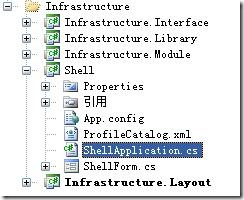应网友要求,结合参考实现(BankBranchWorkbench)写一篇关于 SCSF 内部工作原理的文章,需要读者有 SCSF 基础。基本概念和基本理念后面相关文章介绍。
SCSF 自动为我们建立了 Shell 项目。该项目的 ShellApplication 是SCSF 应用的入口程序,该类继承自 SmartClientApplication<TWorkItem, TShell> ,TWorkItem 是要指定的 root workitem ,TShell 是主窗体。
该类的 Main 方法通过 new ShellApplication().Run(); 启动应用。Run() 在父类 CabApplication 中实现,定义了 SCSF 的启动流程:
2 {
3 RegisterUnhandledExceptionHandler();
4 Builder builder = CreateBuilder();
5 AddBuilderStrategies(builder);
6 CreateRootWorkItem(builder);
7
8 IVisualizer visualizer = CreateVisualizer();
9 if (visualizer != null )
10 visualizer.Initialize(rootWorkItem, builder);
11
12 AddRequiredServices();
13 AddConfiguredServices();
14 AddServices();
15 AuthenticateUser();
16 ProcessShellAssembly();
17 rootWorkItem.BuildUp();
18 LoadModules();
19 rootWorkItem.FinishInitialization();
20
21 rootWorkItem.Run();
22 Start();
23
24 rootWorkItem.Dispose();
25 if (visualizer != null )
26 visualizer.Dispose();
27 }
28
其中核心流程有:
1. 首先创建 Builder builder = CreateBuilder();
CreaterBuilder()方法注册了 RootWorkItemInitializationStrategy ,EventBrokerStrategy,CommandStrategy,ObjectBuiltNotificationStrategy 总共四个策略,同时还添加了三个 Policy :SingletonPolicy,BuilderTraceSourcePolicy,ObjectBuiltNotificationPolicy 。
CreaterBuilder() 一般使用 builder.Strategies.AddNew 方法利用 ObjectBuilder 构建策略对象 (例如:builder.Strategies.AddNew<EventBrokerStrategy>(BuilderStage.Initialization))。
2. 子类可以通过重写 protected virtual void AddBuilderStrategies(Builder builder) 来给 ObjectBuilder 添加其他构建策略(在构建对象或者销毁对象时执行的操作)。
3. 初始化 RootWorkItem
这些准备工作做完后,第一件事是创建 RootWorkItem 。RootWorkItem 是通过 CreateRootWorkItem(builder) 完成的,以前面创建的 builder 作为参数:protected internal void InitializeRootWorkItem(Builder builder)。
InitializeRootWorkItem 中首先初始化 RootWorkItem 相关的 Builder 和 Locator (这两个都是 ObjectBuilder 的组件,用与对象创建和依赖注入):
this .locator = new Locator();
其次对 rootWorkItem 进行初始化,主要执行以下三个方法:
InitializeFields():设置或初始化 ObjectBuilder 相关的对象: Builder,Locator,ObjectBuiltNotificationPolicy,还有 workItem 的状态。
InitializeState():通过 Guid 生成本 workItem 实例的 ID (ID = Guid.NewGuid().ToString(););
InitializeCollectionFacades():初始化管理 SCSF 核心组件的对象管理集合: ServiceCollection,commandCollection,workItemCollection,workspaceCollection,itemsCollection,smartPartCollection,eventTopicCollection,uiExtensionSiteCollection 。
RootWorkItem 构建完成后有一个可选的过程是创建 IVisualizer (用于在运行时查看 WorkItem 的状态):
2 if (visualizer != null )
3 visualizer.Initialize(rootWorkItem, builder);
4. 添加服务:
AddRequiredServices() 方法添加的服务有:TraceSourceCatalogService,WorkItemExtensionService,WorkItemTypeCatalogService,SimpleWorkItemActivationService,WindowsPrincipalAuthenticationService,ModuleLoaderService,FileCatalogModuleEnumerator,DataProtectionCryptographyService,CommandAdapterMapService,UIElementAdapterFactoryCatalog 。
AddConfiguredServices() 添加在配置文件中配置的服务,也就是运行我们通过配置的方式决定在 SCSF 框架启动时加载额外服务(Services)。
AddServices() 在 CabApplication 中是一个空的虚拟方法,允许我们创建 CabApplication 的子类来重写该方法以添加需要的 Services 。
5. 验证用户
通过获取在启动过程中注册的 IAuthenticationService 服务来进行用户验证(ObjectBuilder 的具体应用):
2 {
3 IAuthenticationService auth = rootWorkItem.Services.Get < IAuthenticationService > ( true );
4 auth.Authenticate();
5 }
6. 处理 Shell 程序集(可执行的 Shell Assembly)
2 {
3 IModuleLoaderService loader = rootWorkItem.Services.Get < IModuleLoaderService > ( true );
4 Assembly assembly = Assembly.GetEntryAssembly();
5
6 if (assembly != null )
7 loader.Load(rootWorkItem, assembly);
8 }
9
通过 ObjectBuilder 获取已注册的 IModuleLoaderService (默认的是 Microsoft.Practices.CompositeUI.Services.ModuleLoaderService),调用 ModuleLoaderService 的 Load 方法来通过SCSF Attribute(反射和特性)结合 ObjectBuilder 来加载 SCSF 核心组件,包括 Services、 Command 、 SmartParts、UIElement、workspace、Event Broker、State 等,这些属性(Attribute)主要有:ServiceAttribute,ServiceDependencyAttribute,SmartPartAttribute,CommandHandlerAttribute,EventPublicationAttribute,EventSubscriptionAttribute,ModuleDependencyAttribute,StateChangedAttribute,RootWorkItemExtensionAttribute,OptionalDependencyAttribute,TraceSourceAttribute,ComponentDependencyAttribute,WorkItemExtensionAttribute ,以后有时间会专门介绍这些属性的使用。
7. 构建 RootWorkItem (rootWorkItem.BuildUp())
RootWorkItem 通过 builder.BuildUp(locator, type, temporaryID, this, policies) 方法使用 ObjectBuilder 进行构建,前面介绍过 CabApplication 在 CreaterBuilder() 中注册了构建策略 RootWorkItemInitializationStrategy: builder.Strategies.Add(new RootWorkItemInitializationStrategy(this.OnRootWorkItemInitialized), BuilderStage.Initialization),该语句表明在创建 RootWorkItem 时 ObjectBuilder 会执行该策略并调用本类(CabApplication 或者重载的子类)的 OnRootWorkItemInitialized 方法:protected virtual void OnRootWorkItemInitialized()。CabShellApplication (CabApplication 的子类) 重写了该方法:
2 {
3 BeforeShellCreated();
4 shell = RootWorkItem.Items.AddNew < TShell > ();
5 AfterShellCreated();
6 }
其中 RootWorkItem.Items.AddNew<TShell>() 语句创建了新的 TShell 主窗体对象(通过 ObjectBuilder 构建)并加入到 RootWorkItem 的 Items 集合中。
8. 通过配置加载模块(LoadModules())
RootWorkItem 构建完成后,SCSF 会根据 IModuleEnumerator 服务来枚举可以加载的模块(确定需要加载哪些模块),SCSF 中提供了两个 IModuleEnumerator 服务:FileCatalogModuleEnumerator(在配置文件中指明要加载哪些模块,默认的配置文件是 ProfileCatalog.xml )和 ReflectionModuleEnumerator(利用反射和 ModuleAttribute 来确定需要加载哪些模块)。同时 SCSF 的Package Guidance 为我们提供了一个 XmlStreamDependentModuleEnumerator ,用于从 Xml Stream 中确定需要加载哪些模块,这个可以用在通过 Web Service 将服务器上的配置发送到客户端的情况。
典型的配置文件示例 ProfileCatalog.xml :
 <
SolutionProfile
xmlns
="http://schemas.microsoft.com/pag/cab-profile/2.0%22>
<
SolutionProfile
xmlns
="http://schemas.microsoft.com/pag/cab-profile/2.0%22> <Section Name="
Infrastructure"
>
<Section Name="
Infrastructure"
>
 <
Modules
>
<
Modules
>
 <
ModuleInfo
AssemblyFile
="GlobalBank.Support.Module.dll"
/>
<
ModuleInfo
AssemblyFile
="GlobalBank.Support.Module.dll"
/>
 <
ModuleInfo
AssemblyFile
="GlobalBank.Infrastructure.Module.dll"
/>
<
ModuleInfo
AssemblyFile
="GlobalBank.Infrastructure.Module.dll"
/>
 </
Modules
>
</
Modules
>
 </
Section
>
</
Section
>
 <
Section
Name
="BranchSystems"
>
<
Section
Name
="BranchSystems"
>
 <
Dependencies
>
<
Dependencies
>
 <
Dependency
Name
="Infrastructure"
/>
<
Dependency
Name
="Infrastructure"
/>
 </
Dependencies
>
</
Dependencies
>
 <
Modules
>
<
Modules
>
 <
ModuleInfo
AssemblyFile
="GlobalBank.BranchSystems.Layout.dll"
Name
="BranchSystems.Layout"
/>
<
ModuleInfo
AssemblyFile
="GlobalBank.BranchSystems.Layout.dll"
Name
="BranchSystems.Layout"
/>
 <
ModuleInfo
AssemblyFile
="GlobalBank.BranchSystems.Module.dll"
>
<
ModuleInfo
AssemblyFile
="GlobalBank.BranchSystems.Module.dll"
>
 <
Dependencies
>
<
Dependencies
>
 <
Dependency
Name
="BranchSystems.Layout"
/>
<
Dependency
Name
="BranchSystems.Layout"
/>
 </
Dependencies
>
</
Dependencies
>
 <
Roles
>
<
Roles
>
 <
Role
Allow
="Greeter"
/>
<
Role
Allow
="Greeter"
/>
 <
Role
Allow
="Officer"
/>
<
Role
Allow
="Officer"
/>
 <
Role
Allow
="BranchManager"
/>
<
Role
Allow
="BranchManager"
/>
 </
Roles
>
</
Roles
>
 </
ModuleInfo
>
</
ModuleInfo
>
 </
Modules
>
</
Modules
>
 </
Section
>
</
Section
>
 <
Section
Name
="LinesOfBusiness"
>
<
Section
Name
="LinesOfBusiness"
>
 <
Dependencies
>
<
Dependencies
>
 <
Dependency
Name
="Infrastructure"
/>
<
Dependency
Name
="Infrastructure"
/>
 <
Dependency
Name
="BranchSystems"
/>
<
Dependency
Name
="BranchSystems"
/>
 </
Dependencies
>
</
Dependencies
>
 <
Modules
>
<
Modules
>
 <
ModuleInfo
AssemblyFile
="GlobalBank.BasicAccounts.Module.dll"
>
<
ModuleInfo
AssemblyFile
="GlobalBank.BasicAccounts.Module.dll"
>
 <
Roles
>
<
Roles
>
 <
Role
Allow
="Officer"
/>
<
Role
Allow
="Officer"
/>
 <
Role
Allow
="BranchManager"
/>
<
Role
Allow
="BranchManager"
/>
 </
Roles
>
</
Roles
>
 </
ModuleInfo
>
</
ModuleInfo
>
 <
ModuleInfo
AssemblyFile
="GlobalBank.CreditCardAccounts.Module.dll"
>
<
ModuleInfo
AssemblyFile
="GlobalBank.CreditCardAccounts.Module.dll"
>
 <
Roles
>
<
Roles
>
 <
Role
Allow
="Officer"
/>
<
Role
Allow
="Officer"
/>
 <
Role
Allow
="BranchManager"
/>
<
Role
Allow
="BranchManager"
/>
 </
Roles
>
</
Roles
>
 </
ModuleInfo
>
</
ModuleInfo
>
 </
Modules
>
</
Modules
>
 </
Section
>
</
Section
>
 </
SolutionProfile
>
</
SolutionProfile
>
确定要加载那些模块后,就会执行上面 “6. 处理 Shell 程序集”中的过程,利用注册的 IModuleLoaderService 加载模块。SCSF 规定每个 Module 程序集都有一个继承自 ModuleInit 的子类,IModuleLoaderService 会在加载完该 Module 后自动调用其 void Load() 方法,这里是 SCSF 为我们通过的接入点,我们应该在 void Load() 方法中初始化本模块。具体应该初始化什么以后介绍。
9. 完成对 RootWorkItem 的创建(rootWorkItem.FinishInitialization())
主要是处理 workItem 扩展(以后介绍),并触发创建完成事件:
2 {
3 IWorkItemExtensionService extensionsService = Services.Get < IWorkItemExtensionService > ();
4 if (extensionsService != null )
5 extensionsService.InitializeExtensions( this );
6
7 OnInitialized();
8 }
9
同时 WorkItem 的 public void InitializeWorkItem() 是一个注入方法,有[InjectionMethod]属性标记,该方法执行时除了执行上面 rootworkItem中的初始化过程外,还会调用 InitializeServices 方法,该方法在 CabApplication 中是空方法,CabApplication 子类可以重写 protected virtual void InitializeServices() 方法,用于在 WorkItem 初始化时加载其他需要的服务。
10. 执行 rootWorkItem 的 run 方法 rootWorkItem.Run();
WorkItem 的 Run 方法直接调用 protected virtual void OnRunStarted() 方法:
2 {
3 OnRunStarted();
4 }
OnRunStarted 方法触发 RunStarted 事件(public event EventHandler RunStarted)
2 {
3 if ( this .RunStarted != null )
4 {
5 this .RunStarted( this , EventArgs.Empty);
6 }
7
8 if (traceSource != null )
9 traceSource.TraceInformation(String.Format(
10 CultureInfo.CurrentCulture,
11 Properties.Resources.TraceWorkItemRunStarted, ID));
12 }
13
因此我们可以通过注册 RunStarted 事件或者在 WorkItem 子类中重写 OnRunStarted() 虚方法以便在 SCSF 启动过程中执行自己的操作,这是 SCSF 的又一扩展点。
11. 启动应用 Start()
CabApplication 中的 Start 是一个抽象方法:protected abstract void Start();
子类 FormShellApplication(public abstract class FormShellApplication<TWorkItem, TShell> : WindowsFormsApplication<TWorkItem, TShell>) 重写了Start :
2 {
3 Application.Run(Shell);
4 }
很简单,这时主窗体就显示出来了,以后的整个操作就是通过用户交互来触发了。
以上只是简单的介绍了一下 SCSF 的启动流程,还有很多细节后面的文章会接受。





















 2135
2135











 被折叠的 条评论
为什么被折叠?
被折叠的 条评论
为什么被折叠?








